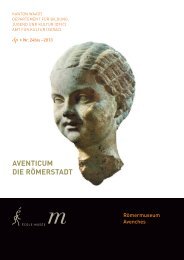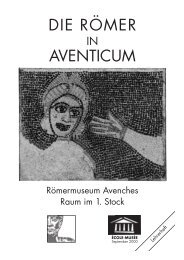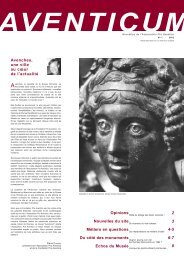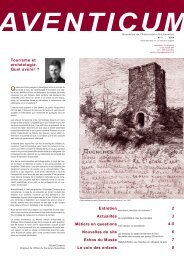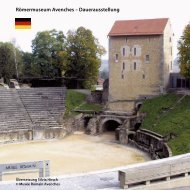Avenches – Roman Museum – Permanent Exhibition
Avenches – Roman Museum – Permanent Exhibition
Avenches – Roman Museum – Permanent Exhibition
You also want an ePaper? Increase the reach of your titles
YUMPU automatically turns print PDFs into web optimized ePapers that Google loves.
First Floor The Early Days of Aventicum<br />
First Floor<br />
The Early Days of Aventicum<br />
(Display cases 1-2)<br />
The name Aventicum derives from a local Celtic water deity, Aventia, tutelary of the<br />
<strong>Roman</strong> city (display case 2, no. 1).<br />
Because of its central position on the Swiss Plateau, the region of Aventicum has<br />
been inhabited for a very long time; its easy access to the river and lake network<br />
favoured the expansion of commerce and trade.<br />
On several occasions, settlement traces dating from periods prior to the <strong>Roman</strong><br />
conquest have been found both inside and outside the city walls (Late Bronze<br />
Age, Hallstatt and La Tène periods). In 58 BC, the Helvetii who had entrenched<br />
themselves in the oppidum of the Mount Vully (1) left their homes and migrated<br />
towards southeastern Gaul. After their defeat by Julius Caesar’s army at Bibracte<br />
(present-day Mount Beuvray in Burgundy), they were forced to return. It is likely that<br />
some of them settled on the heights of the Bois de Châtel hill south of <strong>Avenches</strong>.<br />
The hill of <strong>Avenches</strong> may also have served as a refuge.<br />
Only a small number of remains date from the period immediately preceding<br />
the establishment of the first urban complex, namely from the 1st century BC. They<br />
were discovered in religious contexts such as sanctuaries or tombs (display case 1,<br />
no. 1) situated on the slopes of the <strong>Avenches</strong> hill. These early finds are indigenous<br />
Celtic objects such as fibulae (display case 1, nos. 6-7), painted ware (display case 1,<br />
no. 5) or fine grey ware (display case 1, no. 4) as well as coins (display case 1, nos. 9-12).<br />
Some of them also provide evidence of trade relations with Italy (display case 1,<br />
no. 2) and Gaul (display case 1, no. 3).<br />
The Celtic coin punch (display case 1, no. 8) is of particular interest. A mere 30<br />
such objects are known in the Celtic world including that discovered on Mount<br />
Vully. It is a bronze punch, which was used to strike the obverse of a Celtic denarius.<br />
A cremation burial, which was discovered in the area of the settlement,<br />
dates from the beginnings of Aventicum, i.e. from the late 1st century BC or early<br />
1st century AD (display case 1, no. 14). The urn, a small ceramic bowl, contained the<br />
ashes of a woman and two bronze fibulae were deposited on top. The coin no. 13<br />
(display case 1) dates from the same period.<br />
Thanks to wood preserved in the ground (2) it is possible in several cases to<br />
establish the exact felling dates of the trees used for the construction of the first known<br />
buildings of Aventicum. In this instance, the assistance provided by dendrochronology<br />
(dating of the tree rings of a piece of timber) is particularly efficient. Accordingly, the<br />
construction of the port began in AD 5; the trees used to build the earliest houses<br />
discovered to date were felled in autumn/winter AD 6/7. These houses were already<br />
part of the orthogonal road network typical of <strong>Roman</strong> towns.<br />
1<br />
2<br />
21<br />
First Floor<br />
1<br />
2



